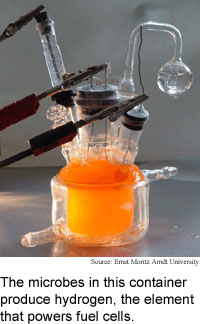
Munching microbes feed fuel
cell
Researchers from the Ernst Moritz Arndt University
in Germany have found a way to harvest the energy needed to power a fuel
cell from chemical reactions that occur when E. coli bacteria consume sugar.
The researchers' prototype microbial fuel cell captures the hydrogen
produced when the microorganisms metabolize carbohydrates like sugar in
the absence of air. Most fuel cells use hydrogen as fuel, capturing the
energy released when hydrogen reacts with oxygen to produce water.
The key to the researchers' prototype, which produces up to 1.5
thousandths of an amp and can run for hours at a time, is that the anode
is coated with a conducting polymer. This layer allows hydrogen to diffuse
through, but blocks larger molecules. It is also involved in an oxidation
reaction that cleanses the anode of excreted metabolites that would otherwise
gum up the works.
The fuel cell produces enough power to continuously run the 0.4
volt motor of a ventilator, according to the researchers.
It will take the least five years to produce practical microbial
fuel cells, according to the researchers. The work appeared in issue 25
of Angewandte Chemie.
VR accommodates reality
Fractals support growing organs
Eyes off, screen off
Chip senses trace DNA
News briefs:
Laser bursts pierce fog
Electricity loosens tiny bits
Nano light stores data in polymer
See-through magnets hang tough
Munching microbes feed fuel cell
Crystal cracks nurture nanowires

Research Watch blog
View from the High Ground Q&A
How It Works
RSS Feeds:
News
Ad links:
Buy an ad link
Ad links: Clear History
Buy an ad link
|
TRN
Newswire and Headline Feeds for Web sites
|
© Copyright Technology Research News, LLC 2000-2010. All rights reserved.